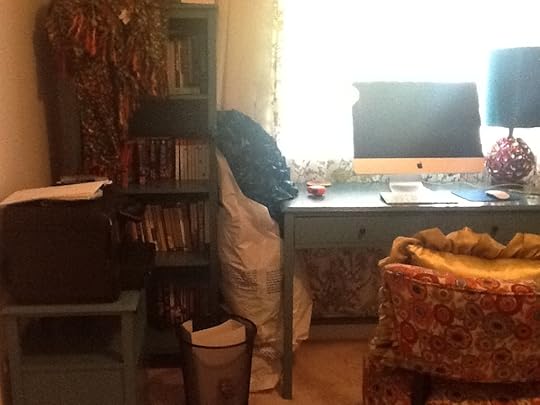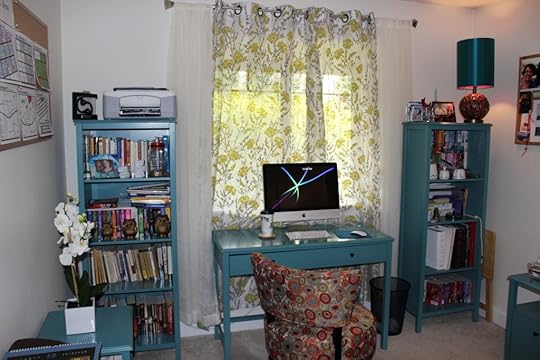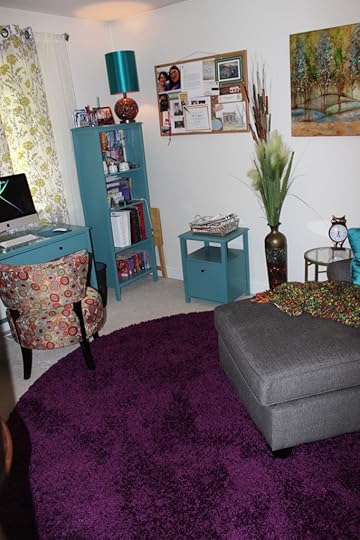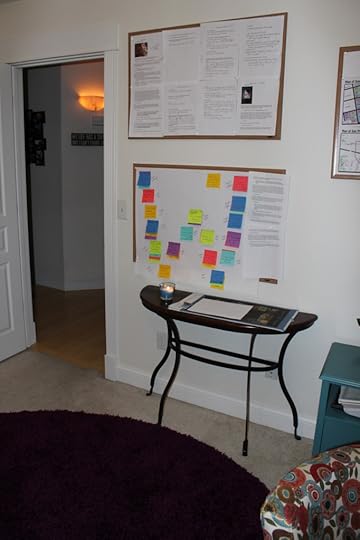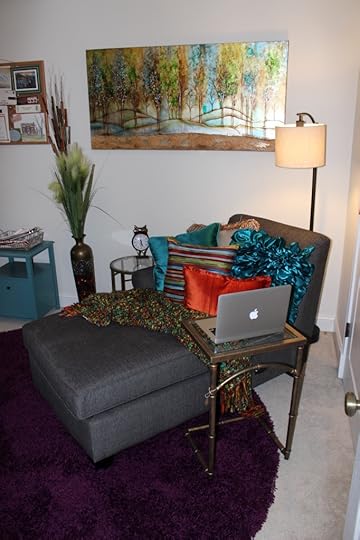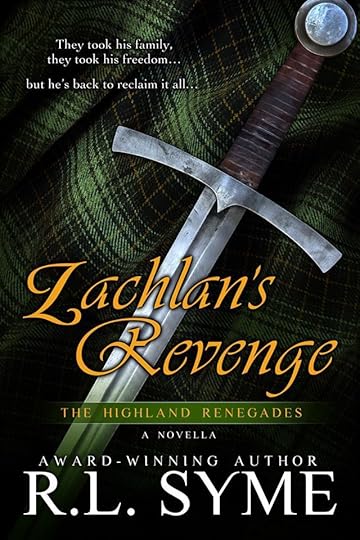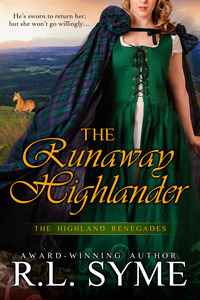R.L. Syme's Blog, page 16
August 4, 2014
My Writer’s Office
This is the second installment of my office re-design series (first installment here). I think I’m almost done, but there are some finishing touches I’m looking to add. I’m still not totally sold on a couple of the elements, but I’m letting myself live with them for awhile so I can decide what I do and don’t want to change. For now, here’s a pictorial representation of my new office.
First of all, here’s what it used to look like (flags, cabinets, and mis-matched furniture… oh, and that’s my dad):
I sold all the furniture, moved the treadmill desk into the living room, where it’s getting more use as an actual treadmill, and not as much as a desk. I bought some new office furniture (which my mother graciously helped me put together–I don’t know what I would have done otherwise… it was a tiring time) and then moved computers and books in.
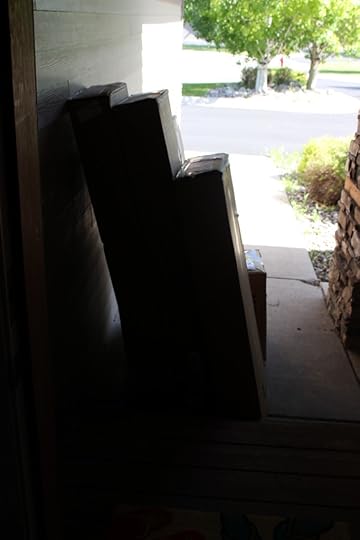
I had all my accents ready to put up, then moved some things around. Got a new office chair, which I adore, put up my plotting boards, moved a sofa table from the living room into the office so I’d have a place to put all my plotting tools when I change books over.
I bought curtains, an accent clock, and something to add a little height. Most of the purchases, however, were furniture.
All in all, I stayed pretty close to budget.
So far, my favorite place to use is the chaise lounge, because I spend a lot more time reading there. That’s why I wanted it. I wanted a dedicated reading spot and I do feel like it’s getting used for that. I love it.
All in all, I’m very happy with it. My favorite part of the decor? The plushy purple rug. It feels great on my toes in the morning when I bring my fresh-pressed arya darjeeling tea in to work on Cambry Quinn and the Copper Hollow.
This was definitely worth it.
August 3, 2014
Cover Reveal: Renegades Novellas
The wonderful and talented Kim Killion has given me the covers for my two new novellas, which will fall (respectively) after Runaway Highlander and then after Pirate Highlander in the series. The easiest way to remember where they belong is that they are the same color as the cover of the book they follow.  Green – Runaway. Blue – Pirate. Grey – Counterfeit.
Green – Runaway. Blue – Pirate. Grey – Counterfeit. 
So, without further ado… here is Malcolm’s Return…
and Lachlan’s Revenge…
August 2, 2014
Upcoming: Creating Sticky Author Newsletters
For Celtic Hearts Romance Writers, coming this August 3rd, I will be teaching my newsletters class. I use a combination of the “Stickiness” theory from Malcolm Gladwell’s The Tipping Point and my own training and experience having created newsletters professionally.
June 7, 2014
Counterfeit Highlander Cover Reveal

Book Four in the Highland Renegades series will be the story of Duncan Sinclair and his quest to protect his family. Check out this beautiful new cover, directly from The Killion Group!
Duncan Sinclair lost his true love but gained a daughter. After the wars with England reach
all the way into the Highlands and his siblings’ mounting marriages make home unbearable,
Duncan takes his child to family in France only to find them as deeply divided as his own. He
engages a nurse to care for his sick daughter, only to find that she isn’t quite what she seems.
Riann Wallis has been running from her family’s legacy for longer than she can remember.
When her last bodyguard dies, she sees another conspiracy and runs right into the arms of
Duncan Sinclair. To secure his protection, she’ll do whatever he wants, be whatever he wants
her to be. But as the days pass and she comes to care for Duncan’s young daughter, Riann
must choose between being truthful with a man she’s coming to love and sharing a dangerous
secret that could get them all killed.
Coming in July!

Coming in July! The Pirate Highlander. Book Three of the Highland Renegades series. Check back for more details. Here’s the blurb and cover for your perusal. 
Malcolm Sinclair left home to find his fortune and instead found his doom. What he thought was a Dutch merchant vessel turned out to be a pirate ship captained by the Lion of the Sea himself, Brecht de Wit. Without realizing what he’s done, Malcolm ingratiates himself to de Wit and finds a home among these criminals that he’s never known. Instead of following through with his plans to turn de Wit in to the Sheriff of Berwick, Malcolm becomes the son that Brecht never had.
Lilian Mason was once a lady, and she once had a brother. But the pirate known as the Lion of the Sea murdered her sweet brother and Lilian has never been the same. She’s spent years infiltrating criminal circles, trying to get to de Wit with no luck. But when she tricks her way onto de Wit’s ship at last, she uncovers more than she bargained for, and finds more than her life in jeopardy when the handsome stranger who saves her life turns out to be the very man she’s come to kill.

May 7, 2014
What Belongs In An Author’s Office?

As I mentioned on Facebook yesterday, I’m planning a DIY project this summer. I want to re-design my office. (Or perhaps, more accurately, design it. I’m not sure it currently has a design to re.) In my defense, I do think that because I live alone, there are things about my style that just haven’t been solidified. But having a lot of married friends and finally owning my own house has given me the design bug.
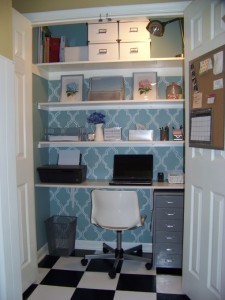
From a home-user of an HGTV design competition
A friend has been designing her new home-office this winter and the process she’s gone through has made me ask myself a few questions. What makes a good office? What belongs in an office? What doesn’t belong in an office?
My friend was initially planning to build a closet-office in her guest bedroom. You’ve all seen these, right? These are common in high-efficiency apartments and small houses now. Or in houses without dedicated office rooms. Some of them are extremely cute.
Most of them have some kind of paint element in the background. (I like this one, that has the wall pattern or wall paper.) Most of them have installed shelves. Almost all of them are designed to have the door closed when not being used. That can definitely be appealing.
My friend finally decided to repurpose her guest room (which most days goes unused) into an office with a daybed that could be re-purposed quickly if she needed guest space.

This is from a place called DesignSponge. Pretty, eh?
For myself, I have a dedicated office space. Thankfully, when I found the house, it came with a nice little space for an office that works out quite well for me. I have a huge roll-top desk. I have a nice treadmill desk (that I don’t really use as a desk anymore, but I do still use as a treadmill). I have a couple of filing cabinets. A bookshelf. And a ton of flags. Seriously. There are flags on every visible wall surface. None of the furniture matches. It’s a lot like a college dorm room.
I’ve been looking at a lot of different office designs. Mostly on Pinterest. I am a Pinterest nerd. I have an entire office re-design board now. And my friend who just re-designed her home office is extremely interested in what I want to do with my office.
We’ve had many long conversations about what I want.
I’m moving all of my furniture around, getting rid of unmatchy book-cases. Some of them, I’m going to paint and move around. Paint to match, of course. Moving the treadmill desk. Moving the piano. Getting everything out of the office. So I’ve had awhile to think about what I want.

I wouldn’t mind having a chaise lounge… I’d like to read in my office as well as write.
I know I want color.
I know I want a more functional desk, preferrably with a lot of workspace (which I currently lack).
I know I want some bookshelf space.
I know I want to use my closet for storage. Probably with either shelving or filing space.
I know I want all of the flags to be gone.
I know I want new window coverings.
I know I don’t want to spend much money.
I wouldn’t mind having a chandelier, or a chaise lounge, or an accent rug.
I would like to have a feature or focus wall, but I want to have a functional wall, too. I’d like to have a couple of big pin-boards hung in wood frames on the wall. I have a couple of them that float around, but I’d like to affix them and utilize them a little better than they’re currently being used.
I don’t want to have too much clutter.
I think I’m going to do something similar to what this blogger did, with her pictures, etc. And she managed her cost-breakdown to stay under $1000.
What do you think? When you imagine an author’s office, what do you think should be there? And if you are an author, what do you want in your office? Or what is in your office that you really like and would suggest?
April 14, 2014
My Writing Process

1) What am I working on?
I have two highlander books out right now. Actually, the second one is coming out tomorrow! So I’m working on the third highlander book right now. It’s called The Highland Pirate. To see the cover, join my newsletter today!
2) How does my work differ from others of its genre?
In general, I tend to write medievals with almost no sex in them. I enjoy the complexity of writing the romantic relationships where sex was off-limits, and where a couple really had a different kind of romantic relationship. Because these books are based around real events in history, I wanted the freedom to explore the history and the romance, and have the sex play sort of third fiddle. I love to read all kinds, but I tend to write heroes and heroines who don’t have sex in the book. Tend.
3) Why do I write what I do?
I write all kinds of genres right now (some contemporary, some historical, different historical genres, some YA, some NA… I love all romance!), but the one thing that unites all of my stories is the happy ending. I think romance without a happy ending is depressing. I want to see people together, so I want to write stories where people end up together.
4) How does your writing process work?
Generally, I do a lot of research and character work on the front end. I’ll read a bunch of research books, do character exploration, and get to know my people, and then get my plotting complete. I may start writing the very beginning of the story, but usually, I have at least my major ducks in a row before I start writing. I’ve learned that my characters are going to tell their own story, so it’s best to know and trust them before we do too much work together.
Next week, check out my good friends Amy and Tameri, and their blogs on their writing process!
Tameri Etherton blurs the lines between fantasy and reality with kickass heroines and the rogues who steal their hearts.
Amy Krohn wrote a short story collection entitled A Flower in the Heart of the Painting, and she spends her life with her three young children and her farmer husband.
March 6, 2014
Writers Breaking Bad
If you’ve never been around writers, let me tell you a little secret. Every author is different. Not only in the way that people are different, but also between genres.
Fiction writers, for instance, have a different kind of life and outlook on writing than do poets. While I’ve always known this to be true, it definitely was more obvious to me when my good friend Amy, debut author of a short-story collection, who is a poet at heart, did the same “Writing Process” blog than I did. I really like what she has to say about her writing process.
If you have a minute, head over and check her out. And tell her I sent you. 
March 5, 2014
Why Saying No is Better Than Thumbs

I’ve been looking for something to give up for Lent. Kristy is giving up some very surgical stuff this Lent and it reminded me, I’ve been trying to come up with something good. Let me say something, first, about why I think it’s important to give something up for Lent.
There is a dearth of opportunities in our culture to look up to people who deny themselves what they could have. Everything focuses around being happy, and in order for us to be happy, supposedly, we’re supposed to buy/have whatever we want. In every area of life, being denied something you want–we are told–is the worst possible thing in the world.
I beg to differ. Disciplining our instincts is what sets us apart from animals. Forget opposable thumbs. Saying NO.
But more than being awesome, giving up something for Lent is necessary. At least for someone like me, who rarely says no to herself, and even more rarely has no said to her. Lent is the only time, really, when I actively deny myself anything. And if you live a life where you deny yourself nothing, you cut yourself off from half the human experience. And most of history. And the requirements of our faith. But that’s the least important reason, for most of us. It may be the most important to some, but let’s be honest, most of us don’t care that much about discipline. Or obedience. We’d rather be the captain of our own ship.
Regardless of why we do it, I’m the most interested in doing it. Try it out yourself. Just say no. I’ll wait.
Saying no over a long term can make you a better person. If the ability to control our instincts really does set us apart from animals (which I can vouch for–my cat doesn’t say no to any instinct… he barely tolerates it when I say no to his instincts), then shouldn’t the compounding of that no make us more human?
Think of it this way. If everyone said yes to every instinct, every desire, every want… that’s how we get drug addiction, gluttony, rape, theft… okay, yes, I’m exaggerating, but follow this track with me for a minute. If what we’re really here for is to have our every desire, every want, every instinct fulfilled, then who are we to judge those instincts? Why is it not good for us to gratify every single desire, every single instinct? And if we are going to set boundaries on some of the instincts that are inherently bad, then why not on some that may not be bad in nature, but can produce negative effects? This is all we’re trying to do. Curb our baser instincts.
Sure, opposable thumbs will do in a pinch, but I prefer saying no. Opposable thumbs will do for any caveman. It takes a truly human being to say no. And mean it.
So what will I give up this Lent? You know, I’m not completely certain yet. I’m sure inspiration will strike. I’ve put the call out on Twitter and Facebook and surely someone will answer.
But this Lent, I’m going to be doing more than just denying myself. I’m going to add to the world, as well. I’ll find some way to give back, and I’ll find some way to deny. Live a life of fullness while also living a life of denial. Isn’t that also the essence of being truly human? It’s certainly the story of my life.
March 2, 2014
Half the Battle (Or. Absolutely Worthless Writing Advice)

There used to be (and maybe there still is) a very famous quote that says: “Knowing is half the battle.” This was my favorite quote for years. It was a good reminder to be aware and self-aware. It was also a reminder that there is another half to the battle, even after you realize you’re already neck-deep.
When I first started writing, I devoured everything that said “What Agents Really Want” or “Top Editor Pet Peeves” or “Tips Every Writer Should Know” or anything of the sort. I couldn’t get enough knowing. I was, as most writers are, looking for that silver bullet. The one thing I was doing that was keeping me from being published.
Because I won enough contests and got enough “love your writing” feedback on my smaller pieces of writing (somewhere between a chapter and 30 pages) to know I had writing talent. I’d also had enough “great voice” comments to know I could sparkle when I had to. (Or at least occasionally.)
 So I was really looking for what I was doing wrong. I really wanted to know what these agents and editors had to say about why I wasn’t making the cut.
So I was really looking for what I was doing wrong. I really wanted to know what these agents and editors had to say about why I wasn’t making the cut.
Here was the big problem. (And some of you may be in the same place.)
I was in the wrong 50%.
The blog posts about what bothered agents and editors were talking about those Other people. People who don’t look at what genres an agent/editor actually wants to read (or doesn’t want). People who don’t follow agents or editors on social media. People who don’t belong to a professional author organizations. People who don’t go to writing conferences or take workshops or go on retreats or talk to other writers.
And the blog posts that talked about what agents and editors were looking for also didn’t apply to me. I was acting like a professional. I had a platform. I was doing my research. I was finishing books. I was invested in my career. I was reading books, following agents/editors, asking questions, entering contests, following the rules.
 But I was in a place where the rules ran out.
But I was in a place where the rules ran out.
For the first 50%, knowing is half the battle. Knowing what people want, knowing how to navigate the profession, knowing what the rules are… that’s the first 50%.
For the next 50%, there is no blog post, no list of pet peeves, no list of wants… there is nothing definitive. Because you can’t define good. It’s subjective.
I’ll never forget going to a panel at RWA where five high-powered agents and editors sat behind microphones and answered all of our questions. Almost every single author asked some version of the same question. “What do you want?” We eagerly sat, each time it was asked in a different way, waiting for the industry professional to drop their knowledge bomb and tell us exactly what was wrong with our book and why it wasn’t getting picked up.
By the end of the panel, these industry professionals got sort of sick of answering the question with a list of genres that were currently cool (which was helpful to some) and they would just pass a look around the table and then say some version of: “Tell me a great story.”
 Cue the wide-eyed blank stares.
Cue the wide-eyed blank stares.
Well, great. Thanks. I think I am telling a great story. So does that mean you’ll be my agent slash publish my book? Still no? Well, what can I do? “Give me a compelling main character.”
Well, great. Thanks. I think I have a compelling main character. I certainly talk about him/her like s/he is compelling. So, does that mean you’ll be my agent slash publish my book? Still no?
More blank stares.
So, what you’re telling me is… there is no definitive answer. There is no way, once you pass the 50% where they just don’t know why. Sometimes, even when they read it, they don’t know why. And what one person rejects, another might adore.
So after a certain point in your writing career, you’re going to reach the place where posts about writing advice are pretty much worthless. For this second 50% (which will last the rest of your career), you need a couple of things.
 1) A Self-Censor. Not to edit your writing, but to keep you from wasting time. You’re at the point in your career where finishing books is going to be the most important thing you can do. So stop reading blog posts about how to be a better writer. Be strategic about the workshops you take. (In other words, stop taking everything. Start taking the workshops that will correct your weak spots. Or that will help you at your particular stage of the career.) Stop scouring the internet for tips. Start finishing manuscripts, and then…
1) A Self-Censor. Not to edit your writing, but to keep you from wasting time. You’re at the point in your career where finishing books is going to be the most important thing you can do. So stop reading blog posts about how to be a better writer. Be strategic about the workshops you take. (In other words, stop taking everything. Start taking the workshops that will correct your weak spots. Or that will help you at your particular stage of the career.) Stop scouring the internet for tips. Start finishing manuscripts, and then…
2) Get a Good First Reader. For some people, this is a critique partner. For others, this is a spouse. For others, it’s an agent. For others, it’s a freelance editor. For others, it’s a reader. Whoever it is, find someone who’s going to read your books, tell you what they love, and what needs to change.
3) Be Edited. Learn how to rewrite. Learn how to edit. Or find a process of someone else editing that works for you. And for God’s sake, finish manuscripts.
Then, start fighting your way through the second 50%. It might be that you have to query a few more frogs before you find your prince/ss.
But knowing is half the battle. And once you know, continuing to try to know more is only going to get you stuck where you currently are. Don’t let the fear of big goals or the lack of ability to focus or the belief in a magic bullet stop you from getting right along on the journey.
Fight the half of the battle that’s left to fight. Don’t rehash the half you’ve already won. Just sayin.
Less than a month until my April 1st release, the second of the Renegade Highlanders series, The Runaway Highlander. To sign up for my newsletter and learn more about my books, click here.


